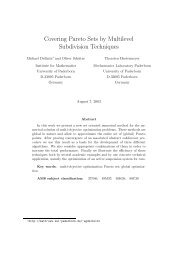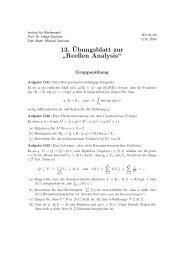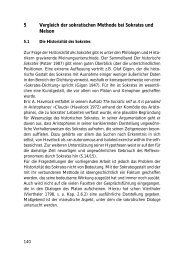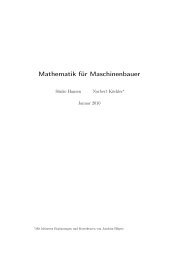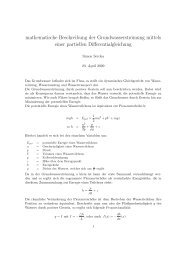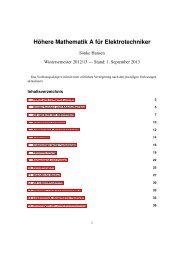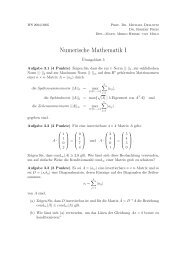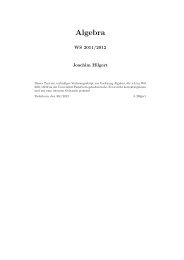Partial Differential Equations
Partial Differential Equations
Partial Differential Equations
Create successful ePaper yourself
Turn your PDF publications into a flip-book with our unique Google optimized e-Paper software.
we obtain the estimate<br />
|L ε | ≤ n‖Df‖ ∞<br />
∫<br />
∂B(0;ε)<br />
|Φ(y)| dS ∂B(0;ε) (y) ≤<br />
Applying integration by parts again, we find<br />
∫<br />
∫<br />
K ε = ∆ y Φ(y)f(x − y) dy −<br />
∫<br />
= −<br />
R n \B(0;ε)<br />
∂B(0;ε)<br />
∂B(0;ε)<br />
∂Φ<br />
∂ν (y)f(x − y) dS ∂B(0;ε)(y)<br />
1.2 The Laplace Equation 9<br />
{<br />
Cε| log ε| for n = 2,<br />
Cε for n ≥ 3.<br />
∂Φ<br />
∂ν (y)f(x − y) dS ∂B(0;ε)(y)<br />
since Φ is harmonic in R n \ {0}. Note that ν(y) = y ε<br />
for y ∈ ∂B(0; ε). Moreover, we have<br />
0<br />
ε<br />
y<br />
1<br />
Fig. 1.4.<br />
From this, for n ≥ 3, we obtain<br />
DΦ(y) =<br />
{<br />
−<br />
1<br />
2π<br />
y<br />
− 1<br />
nα(n)<br />
|y| 2 ∀y ≠ 0 if n = 2<br />
y<br />
|y| n ∀y ≠ 0 if n ≥ 3.<br />
∂Φ<br />
∂ν (y) = ν(y) · DΦ(y) = − 1<br />
nα(n)ε n−1<br />
∀y ∈ ∂B(0; ε).<br />
The surface area of ∂B(0; ε) is nα(n)ε n−1 . Now, the continuity of f in x gives<br />
K ε = −<br />
1<br />
nα(n)ε n−1 ∫∂B(0;ε)<br />
f(x − y) dS ∂B(0;ε) (y) −→<br />
ε→0<br />
−f(x).<br />
Similarly we find K ε −→<br />
ε→0<br />
−f(x) also for n = 2. Together with the already proven estimations for L ε and<br />
I ε , we finally conclude<br />
∆u(x) = lim<br />
ε→0<br />
(I ε + L ε + K ε ) = −f(x).<br />
Let U ⊆ R n be open and bounded with smooth boundary ∂U. We consider the boundary value<br />
problem which corresponds to the Poisson equation:<br />
{ −∆u = f on U,<br />
(1.9)<br />
u = g on ∂U,<br />
where now f : U → R and g : ∂U → R are given, and u: U × R + → R is the unknown function (U is the<br />
closure of U in R n ).<br />
For an open subset U of R n , let C k (U) be the space of all functions u: U → R whose restriction onto<br />
U lies in C k (U) and whose partial derivatives up to order k are all uniformly continuous on U (thus, they<br />
can be extended onto U).




